I’ve been lucky enough to work with the best hockey players on the planet in my time working in the National Hockey League. Now, it’s my mission to help deliver the same type of training that helped those players stay fast and strong to anyone and everyone that is willing to put in the work. I recently launched an online training option so that I can reach and impact hockey players around the globe and you can actually sign up below.
“Bantam Back” is a description of a lumbar stress fracture in youth hockey players. For those unfamiliar, Bantam refers to hockey players ages 13-15 years old. Basically, it is Spondyloylsis which is a stress fracture in the pars interarticularis of the lumbar vertebrae which is a small bone joining 2 vertebrae. These fractures can happen from repetitive stress.
Unfortunately, this condition has been popping up frequently in recent years. I first heard of this condition from John Bottoms, a Minneapolis based Physical Therapist. The frequency of how many kids are in his clinic for this shocked me. What can strength and conditioning coaches do during the reconditioning process and what can they do to help prevent them from happening in the first place?
https://orthoinfo.aaos.org/en/diseases–conditions/spondylolysis-and-spondylolisthesis/
From my personal observation, the typical Bantam Back individual is a longer/taller player. They also may have recently had a growth spurt. I imagine it could happen with shorter players but from what I have seen, they’ve been on the taller side. They also play hockey on a year-round basis.
Although I do think that repetitive rotation in shooting is a contributing factor, I also believe that improper skating technique contributes. Specifically, when skating mechanics break down (“bag” skating or punishment skating after practices). This is where players can become more straight-legged versus maintaining a proper back position and knee bend. I also believe that there is an inability for coaches and players to determine the proper depth and technique for skaters. I think we can get confused when teaching taller players to get low while skating. For example, a taller player may not look low in comparison to smaller players. However, when you take hip and knee angles into consideration, they may be closer than you think. I believe that the stress in the back is higher for taller players who maybe coached to get lower. When you add in repetitive and useless conditioning drills- the outcome isn’t good.
The prescription when diagnosed with Bantam Back is 3 months of no activity. However, physical therapy can begin during that time. This is crucial so that the fracture can heal while also removing any activities that may have helped caused the injury in the first place. In the recovery process, the no activity prescription is strict. Some orthopedic specialists may recommend a back brace during the 3 months.
What can happen is that people don’t listen to the doctor’s advice. Maybe the player is diagnosed during the competitive season? Maybe a showcase that is heavily scouted is coming up? It doesn’t matter. The 3 months off is key. I understand that this isn’t good news but I look at it as a time to reset and refocus on some things before returning to the ice. The payoff is bigger in the long run.
The treatment plan at the beginning consists of low level core exercises and stretches specifically for the hamstrings and hip flexors. The progression gradually becomes challenging from low level to more functional applications so that the player can return to the ice. Usually, the rehabilitation combined with the 3 months of rest results in a positive outcome.
What can Strength and Conditioning Coaches do to help these situations and what can they do to help prevent from them happening?
Although I don’t think it is appropriate, year-round hockey is normal nowadays. Players have more opportunities to play outside of the winter hockey season. It is important to participate in other sports and/or recreational activities. I think that the time off the ice and away from hockey is important. When I think about the professional players that I get to work with, they take a minimum of 1 month off of the ice when the season ends. When they do return to the ice, the intensity and duration is progressed over the next few months up until training camp. Bantam aged players are not professionals. Their bodies are still maturing. I think the 3-month activity is a blessing for those who suffer from bantam back.
When it comes to exercises and progressions, I think it’s important to note that I am not a Physical Therapist (PT). I do help with the reconditioning of athletes. I also use exercises that PT’s will use with injured athletes with the healthy athletes that I work with. I truly believe that if a PT prescribes exercises with an injured client, why wouldn’t I want to prescribe exercises with a healthy athlete to help prevent injuries? Whether it is core exercises, pre-habilitation, or functional training- I really don’t care. As long as what we are doing is working and we are simultaneously getting faster, powerful, and stronger.
Where I think the Strength and Conditioning Coach is important is in the return to play phase and then helping the player with preventing this from happening again. When it comes to program design, I think that some modifications need to be made. Avoiding exercises that could promote hyperextension of the lower back while under load could help as well as avoiding axial loading. For example, back squats, front squats, overhead pressing, deadlifting, and Olympic lifting would be discontinued. I do think that there are many ways for an athlete to get more powerful, stronger, and faster without risking further injury.
The Mcgill Torso Muscular Endurance Test Battery (1) is used as an assessment to measure endurance in the trunk flexors, lateral endurance (side bridge), and the back extensors. This can be used as a baseline measurement at the beginning of rehab. During the course of the 3 months, this can be reassessed to see progress.
When it comes to core training, I do think improving performance of the Mcgill Torso Muscular Endurance Test Battery helps. McGill’s Big 3 (2) is a really good safe and simple way to increase not only performance in the Endurance test, but also a way to build a strong and stable back with endurance capabilities. We’ve removed what others refer to as traditional core training and have since been incorporating the Trunk Curl Up, the Side Bridge, and the Bird Dog as well as Glute Bridges for our floor-based exercises.
TRUNK CURL UP
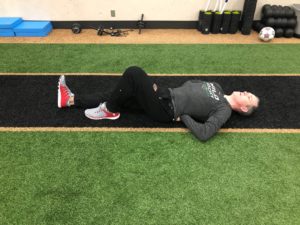
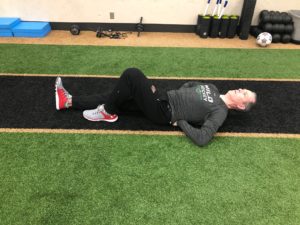
SIDE BRIDGE
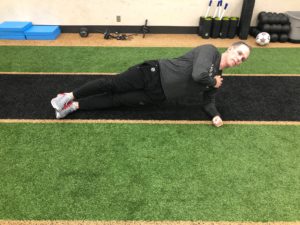
BIRD DOG
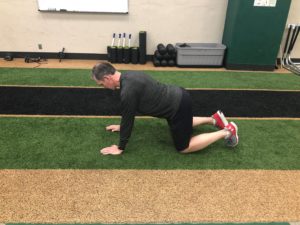
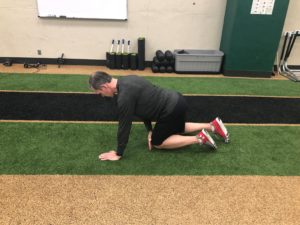
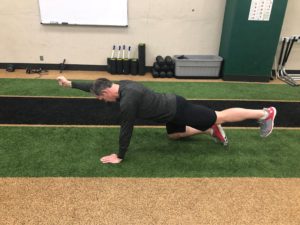
What about Skating? As I mentioned before, I believe that less than adequate skating technique can contribute to Bantam Back. I think that after the 3-month long break, the player needs to be with a good skating coach to help the player possibly re-learn skating technique. The fundamental position of skating needs to be emphasized so that lower back health isn’t compromised. This combined with proper strength and conditioning off the ice can contribute to the player returning back to their normal level of play. I have personally seen kids come back to skate and play again at a higher level.
Again, sometimes an injury like this can be a blessing in disguise. It may sound crazy, but it is 3 months forced rest. Unfortunately, some kids need that today. A young athlete competing year round combined with less attention to technique can be as a recipe for something like this.
- https://www.acefitness.org/cmes-resources/pdfs/02-10-CMES-McGillsTorsoEnduracneTest.pdf
- https://www.livestrong.com/article/392341-stuart-mcgills-big-three-back-exercises/
I like to read books all the time- although I probably don’t read as much as others. Here are some of the books that I have read recently and have almost finished:
Tough to say that this is a book that I am reading but I did purchase it and do read the words on the page on a daily basis. I enjoy starting my day with gratitude writing. I have tried a few of them but I wanted to try a new process. So far so good.
Iron Works Preparation: The Best Way to Prepare for Football
I have really enjoyed listening to Arizona Cardinals Strength and Conditioning Coach Buddy Morris on several different podcasts. I have also read some of his “Coach X” material on Elitefts.com. This book (which is co-authored by Ryan Williams)was another way to see how good strength and conditioning coaches organizes their thoughts and write programs. I am a nerd when it comes to this stuff and enjoy learning how other coaches write programs even if it isn’t for hockey.
Gift of Injury
This is a great resource for me because I have low back pain. I am also always looking for methods that work in the prevention of LBP in my athletes/clients. I have read lots of Stuart McGill’s work but this was different because it was written from Dr. Mcgill’s perspective as well as the athlete’- Brian Carroll. I had the opportunity to meet with Brian at the the annual PHATS meeting in Orlando. It was pretty neat to hear his experience.
Thinking, Fast and Slow
I had a good start with this and I put it down because I found it to be a tough read. I anticipate picking it up again soon.
Would love to hear thoughts and suggestions.
Here is a link to a recent podcast that I did with Steve Breitenstein from TCBoost Sports Performance:
https://itunes.apple.com/us/podcast/the-speed-podcast/id1333698295?mt=2
I had fun participating. I hope you enjoy it!
I like to post these random thoughts that pop up in my head from time to time. Let me know what you think.
-I’ve been using a 1×20 program with my athletes as a Post-Season/Transition phase for the past 3 years. Each off-season, I have found it to be a great re-introduction to the training process with the emphasis on GPP and restoring range of motion under load. Thanks to Strength and Conditioning Coaches like Jim Snider at Wisconsin, Jay Demayo at Richmond University, and ultimately Dr. Yessis.
-I believe more dumbbells and kettlebells and no barbells in this phase.
-With my young athletes who can’t complete a set of 8 chin ups on their own; I’ve had them use assisted pull up variations with bands. I am now going back to adding eccentrics after their last successful repetition. We don’t use the band anymore. For example, if a an athlete can’t execute 8 chin ups, but can get 5, I have them perform a :30 eccentric after their 5th rep. This occurs for all 3 sets that we do in the training session. I feel that the band assisted method doesn’t produce results. The goal is 30 seconds on the eccentric contraction. This will continue even though we aren’t in an “eccentric” phase.
-Tempo is the forgotten variable sometimes in training. Beginners and those in the return to training phase need more time under tension
-For continuing education this summer, I recently attended Charles Poliquin’s Advanced Program Design seminar. I thought it was outstanding. I go to seminars to learn. I’ve never gone to train. However, the practical portion of this seminar was equally beneficial to the knowledge picked up in the lecture portion. It was awesome kind of going back in time for me as I haven’t been to one of his seminars since 2001.
-Charles said something on the lines of a Strength and Conditioning Coach isn’t doing a good job in-season if 90% of strength isn’t maintained. I believe that.
-I love working with youth and high school hockey players during the summer. I believe that consistent work and effort with an emphasis on the basics works.
-I have some requests for off-season program design/on-line training. Please email me a sean@seanskahan.com if interested.
I like the random thought posts because it allows me to share what I am thinking when I sit down to write.
- I’ve been taking an active approach on social media (or more active approach). I’ve always felt that maybe my content stinks and no one will like it or maybe some would think that I don’t actually coach. What I’ve come to realize is that if someone doesn’t like what I put out- who cares? I actually do coach and lots of folks find the content beneficial.
- I’ve been helping out some high school hockey teams this season (which has been fun). We had a few training sessions on the day between games. For example, if the team played Thursday and Saturday- we trained on Friday. We have done some strength training exercises such as body weight step ups and push ups but most of the sessions were tempo running, diaphragmatic breathing, and stretching. Each time they won the next day. Not saying what we did helped them win but it didn’t help them lose.
- I’ve done a consistent job of establishing a morning routine. I’ve become obsessed with personal goal setting over the last few years. Each morning, I get up, make coffee, and write in my Full Focus Planner, read the Daily Stoic, and then hit my Wim Hof inspired breathing exercises and push ups. Something to be said about having a routine that you stick with in the morning before you do anything else. Funny how only a few years ago, I would probably call myself a nerd for doing this kind of stuff.
- Working with pro athletes is both fun and challenging. Having fun while overcoming the challenges makes me a better coach.
- Recovery Facilitator is a large part of the responsibility of the Strength and Conditioning Coach in-season.
Here is a link to a recent podcast that I did with Wil Fleming and Coach Dos.
It was really fun to talk training with these guys. Hope you enjoy!
Here is a short video of some hip hinging exercises and progressions that work for me. These have been great when working with kids in a large group setting.
A common email that I get is usually from a younger strength and conditioning coach who is interested in working in professional sports. “What was the path that you took that got you to where you are ?” First, I am truly honored and humbled that some folks are 1- interested in a similar career, and 2- take the time to ask me what I have done in my experience. I appreciate this because I remember writing and sending emails and letters to Strength and Conditioning coaches, head coaches, and management personnel on my old Dell Computer when I was first starting out. I would like to take a shot at answering.
I would begin by saying that I was lucky to enter the professional hockey ranks at a time when the full-time Strength and Conditioning Coach wasn’t common. At the time, there were part-time strength and conditioning coaches, athletic trainers who possessed their C.S.C.S. (Certified Strength and Conditioning Specialist) who did it in addition to their full-time responsibilities, or outside consultants. I was fortunate to be the first full time Strength and Conditioning Coach for an organization at the time (2002).
The reality it is that it is probably harder to obtain full time employment in professional sports now than it was 16 years ago. Not only is it difficult to work in professional hockey but it is also difficult at every other level of any sport. Strength and Conditioning/Sport Performance is an awesome profession and more people want to become Strength and Conditioning Coaches.
What I would like to do is let you know what I believe worked for me. It is definitely a combination of having a passion for what you want to do, making the right decisions, education, experience, luck, and knowing the right people.
When I was an undergraduate Exercise Science student in college, I decided that I want to become a Strength and Conditioning Coach. At the time, I was a football player who enjoyed strength training. When I found out that there was an profession of coaching athletes in the weight room with the intention of improving performance and reducing the potential for injury- I knew it was what I wanted to do.
What I would like to say to the aspiring Strength and Conditioning Coach is:
Find mentors- I met great people who helped guide me throughout my career. Without them, I wouldn’t be where I am today. They also went to bat for me when a Head Strength and Conditioning Coach or a Head Hockey Coach was looking for a “Hockey guy”. There are so many mentors that I had and still continue to receive guidance from. I wrote about mentors here.
Volunteer/Internships- You will need to get experience. Learn how to coach and interact with athletes, coaches, and administrators. You never know who or where these people might be in the future. Find a way to make it work. Work another job if you have to. I completed 3 internships/part-time opportunities before I went to graduate school.
Master’s degree- I’m not sure if this is 100% necessary. Although I will say that I’ve spoken to several collegiate Head Strength and Conditioning Coaches who will disregard applicants who don’t possess a master’s degree when hiring assistants. Considering that some professional teams that have Directors of Sport Science with PhD’s, I would strongly recommend it.
Take risks and adventures- For me, when I was in my early twenties, I didn’t necessarily want to leave the Boston area. This was where my family and friends were/are. I realized that if I wanted to do this as a profession, I would have to go . I think this coincides with not being afraid of being uncomfortable. Learn new ideas and philosophies from different coaches and work to develop your own.
Work hard- This goes without saying. Arrive early and stay late. Network and read everything that you can. Some resources that I recommend are here.
There are also several paths to working in professional sports. This isn’t necessarily what you have to do. I know of several of coaches who took different paths. I wrote my story to let you know that this is what I did because I believed that this process worked. There were no shortcuts or situations where everything was perfect, but I think things worked out.
Over the past year, I’ve read some really good books. An author of books that I really enjoyed is Ryan Holiday. His books include The Obstacle is the Way, Ego is the Enemy, and The Daily Stoic (which I read on a daily basis).
What Ryan writes about in those books is the philosophy of Stoicism. To me, and what I took away from the books is pretty much trying to embrace living in the moment. The idea of focusing on what is in front of you and not letting outside influences getting in the way. Outside influences would include events or stress that have happened in the past, present, or in the future.
In the athletic world, when the word stoic is used to describe a leader or a coach, I think of Coach Bill Belichick’s “Do Your Job” and Coach Nick Saban’s “The Process”. They are great coaches who emphasize performing the task at hand to the best of your ability with the end result being continuous improvement.
In the Strength and Conditioning world, the overall process can be a grind. The athletes you work with need to be able to do what is in front of them to the best of their ability. The focus must be on the repetition at hand. It can’t be “Damn, I have 3 reps left” or “We have to run shuttles tomorrow”. I think it’s the job of the Strength and Conditioning Coach to help keep your athletes in the moment. Correct their technique, encourage their execution of the task they are performing.
This is important at all levels of athletics. Student athletes in high school and college have way more on their plate. Going to class, taking exams, studying, etc., are all different demands that each student athlete faces. Then, adding team dynamics such as practices, games, role on the team, Iis Coach mad at me?”, on top of that creates a situation where the athlete has a tougher time focusing on the task at and. This is also a reality at the professional level with the exception of being a student. Except for them it is family, financial, and other responsibilities.
In the professional hockey environment, the better players that I have worked with over the years embrace the process of the season. Playing 82 games is a grind and each season has its ups and downs in terms of wins and losses including streaks and slumps. It’s a reason why I think many players are superstitious or have routines that they go through to help them prepare.

